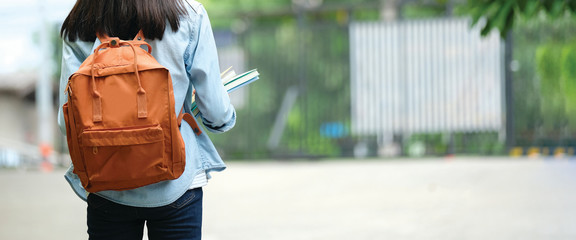Ogni mattina ogni studente prima andare a scuola prepara lo zaino con i libri che gli servono quel giorno: prende il libro di storia, il volume di italiano, l’eserciziario di matematica, con i rispettivi quaderni, l’atlante di geografia e il testo di scienze; infine ci infila la merenda e una bottiglia d’acqua e esce di casa. Se è fortunato, in pochi minuti di viaggio su un autobus quasi vuoto, arriva a scuola e si siede al proprio banco. Ma cosa succede se l’autobus è in ritardo e piove, quindi il suolo è bagnato e non può appoggiare la cartella mentre aspetta? Cosa accade se sul pullman non ci sono posti per sedersi? Cosa succede se invece di prendere l’autobus deve prendere il treno, che è sempre pieno per poi camminare, dalla stazione a scuola, un quarto d’ora perché non ha altra scelta?
Cosa accade se l’unico modo per arrivare a scuola è farsi mezz’ora su una bicicletta mezza rotta perché i suoi genitori non possono permettersi l’abbonamento dell’autobus tanto meno una comoda bicicletta con cestino? Succede che per più di un’ora il povero studente è costretto a portarsi un peso, che varia dai quattro agli otto chilogrammi, sulle spalle che danneggia la salute della colonna vertebrale e la sua postura oltre a causare dolori alle ossa e alla schiena.
Quaranta o trenta anni fa non c’era altra soluzione ma oggi, grazie alle nuove tecnologie e dispositivi, quali libri e testi online, computer, tablet o ebook, potrebbe esserci la possibilità di cambiare le abitudini e alleggerire questi zaini eccessivamente pesanti. Non pochi, tra cui la sottoscritta, rimangono legati ai volumi cartacei e al bisogno di toccare materialmente le pagine del libro su cui si studia. Ma è anche vero che attraverso una trasformazione e una modernizzazione delle tradizioni scolastiche potrebbe non essere più necessario usare i libri a scuola; infatti si potrebbe sostituirli con computer o tablet oppure fare lezioni multimediali e alternative, limitando così l’uso dei testi in un secondo momento, a casa, per fare un ripasso o un approfondimento della lezione del giorno.
Di Alice Rossi 2i
Traduzione in inglese di Alice Rossi 2i
Let’s lighten the backpacks for school, they are too heavy!
Every morning, before going to school, each student prepares his backpack with the books he needs that day: he takes the history book, the Italian volume, the mathematics exercise book, with the respective notebooks, the geography atlas and the text of sciences; finally, he takes a snack and a bottle of water and goes out. If he’s lucky, within a few minutes of traveling on an almost empty bus, he gets to school and sits down at his desk. But what happens if the bus is late and it is raining, so the ground is wet and he can’t put the briefcase down while he’s waiting? What happens if there are no seats on the bus? What happens if instead of taking the bus he has to take the train, which is always full and then he has to walk from the station to school for a quarter of an hour because he has no other choice? What if the only way to get to school is to spend half an hour on a half-broken bicycle because his parents cannot afford a bus pass, much less a comfortable bicycle with a basket? It happens that for more than an hour the poor student is forced to carry a weight, which varies from four to eight kilograms, on his shoulders which damages the health of the spine and his posture and also causes pain in the bones and back. Forty or thirty years ago there was no other solution but today, thanks to new technologies and devices, such as online books and texts, computers, tablets or ebooks, there may be the possibility to change habits and lighten these excessively heavy backpacks. Not a few, including myself, remain tied to the paper volumes and the need to physically touch the pages of the book on which one is studying. But it is also true that through a transformation and modernization of school traditions it may no longer be necessary to use books at school; in fact, you could replace them with a computer or tablet or take multimedia and alternative lessons, thus limiting the use of the texts at a later time, at home, to review or deepen the day’s lesson.
